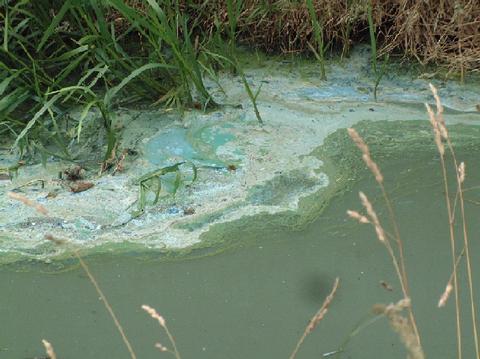Blue-green algae
In our management area we regularly see intensive blooms of blue-green algae in surface water in many places. A sign that the water quality and the nature that depends on it are not doing well. Blue-green algae sometimes produce toxins, which can be toxic and cause a lot of inconvenience: a swimming ban, stench and massive fish mortality. Recreationists, residents and businesses are affected.
What is blue-green algae?
Blue-green algae are not algae, but bacteria with a blue-green color. They occur in all seasons and in all waters. Usually we do not notice them much; the densities are so small that they cannot be seen with the naked eye. But if there are many blue-green algae in the water, a "bloom" occurs. With many blooms, floating layers form: a blue-green paint-like drab substance, which can stink enormously.
Blue-green algae come in different varieties, but they have in common that they grow and flourish when the water gets warmer. They live on phosphates and nitrogen, which they can extract from the water. In addition, they need light and air. Because our waters contain more than enough phosphates and nitrogen, they can often grow here indefinitely. In early spring this already begins. In the summer months they really start to peak.
Beware!
Blue-green algae can be toxic to humans and animals. Especially in floating layers, toxins can occur. But whether toxins always occur in floating layers is hard to say. The same species of blue-green algae can sometimes produce toxins and sometimes not. And some species produce stronger toxins than others. For safety, we always check the bathing water for the presence of toxic blue-green algae. If there is blue-green algae in the water, we always place warning signs.
Checking bathing water
We measure the quality of official swimming water sites in our area. We measure two types of bacteria and we measure the density and toxicity of blue-green algae. You can see the results of the measurements and whether they are good or bad at www.zwemwater.nl. For more information, see the Bathing Water page.
Addressing blue-green algae
Because most waters contain phosphates and nitrogen, prevention is impossible. Only if we can reduce the source, the phosphates and nitrogen, to very low levels do the blue-green algae disappear. But we live in an area where there is a lot of phosphate in surface waters; partly by nature and partly because man has introduced it.
There is limited ability to flush locations where blue-green algae is present with blue-green algae-free water. Sometimes there is no possibility of flushing. In other cases, there may be the undesirable effect of the blue-green algae moving to another location.
With rain and lots of wind, it gets cooler and blue-green algae diminishes. So a bad summer is also bad for blue-green algae. And in the fall they decrease anyway.
Learn more
More information on blue-green algae can be found on the websites of the STOWA (Stichting Toegepast Onderzoek Waterbeheer), the Living Environment Information Point and Rijkswaterstaat.
